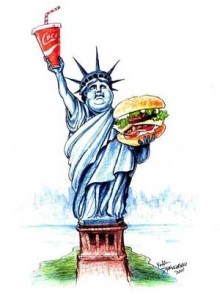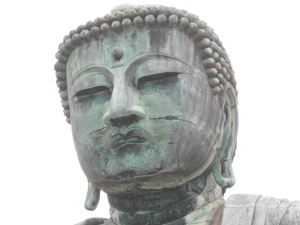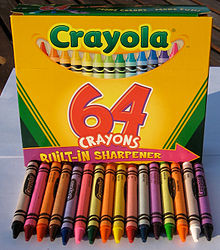 Well the truth is out. The U.S. is no longer “cool” to many Japanese. The Japanese language newspaper, Tokyo Shimbun, reported these conclusions in a late May edition. The following is an English translation of the original article that was sent to me by Assistant Cultural Affairs Officer Sara Harriger of the US Embassy Japan. Sara will speak in our American Culture class on July 11, 2012. The article quotes my friend, Yasushi Watanabe of Keio University, whom I like to call the “Joseph Nye” of Japan. Nye is the originator of the concept of soft power.
Well the truth is out. The U.S. is no longer “cool” to many Japanese. The Japanese language newspaper, Tokyo Shimbun, reported these conclusions in a late May edition. The following is an English translation of the original article that was sent to me by Assistant Cultural Affairs Officer Sara Harriger of the US Embassy Japan. Sara will speak in our American Culture class on July 11, 2012. The article quotes my friend, Yasushi Watanabe of Keio University, whom I like to call the “Joseph Nye” of Japan. Nye is the originator of the concept of soft power.
I believe that the U.S. materialism and consumerist model is losing appeal in a post-3.11 Japan. I’ve been thinking a lot lately about my own ancestry that includes American Indian Mohawk and Creek tribes. The Native American philosophy is counter to modern American values of waste and excess. As the former advertising executive and author Jerry Mander points out here, the Judeo-Christian model of culture has a lack of sustainability built into it that competes with the models offered by Indians:
Judeo–Christian religions are a model of hierarchical structure: one God above all, certain humans above other humans, and humans over nature. Political and economic systems are similarly arranged: Organized along rigid hierarchical lines, all of nature’s resources are regarded only in terms of how they serve the one god–the god of growth and expansion. In this way, all of these systems are missionary; they are into dominance. And through their mutual collusion, they form a seamless web around our lives. They are the creators and enforcers of our beliefs. We live inside these forms, are imbued with them, and they justify our behaviors. In turn, we believe in their viability and superiority largely because they prove effective: They bring us power.
But is power the ultimate evolutionary value? We shall see. The results are not yet in. Survival of the fittest as a standard of measure may require a much longer time scale than the scant 200 years’ existence of the United States or the century since the industrial revolution or the two decades since the advent of high technology. Even in Darwinian terms, most species become unfit over tens of thousands of years. Our culture is using its machinery to drive species into extinction in one generation, not because the species are maladaptive but because pure force wins out. However, there is reason to doubt the ultimate success of our behavior. In the end, a model closer to that of the Indians, living lightly on the planet, observing its natural rules and modes of organization, may prove more fit and may survive us after all. Until that day, however, we will continue to use Darwinian theories to support the assertion that our mechanistic victory over the primitives is not only God’s plan but nature’s.

Have you lost interest in the American culture? Is America more uncool than cool?
Japanese losing interest in U.S. culture Tokyo Shimbun
May 21, 2012, pp. 24, 25
By Yasuyuki Oguri
A shift away from American culture is taking place in Japan. Hollywood movies are no longer popular. American music is not creating any sensations and there has been a sharp decline in the number of students going to the U.S. to study. The U.S.’s “soft power” in Japan has weakened and experts point out that this has never happened before in history. Why has American culture stopped reaching the Japanese people?
Film journalist Hiroo Otaka points out: “American movies are not selling at all. They are doing particularly poorly this year. Not one movie has grossed over 2 billion yen, which is the benchmark for a blockbuster. This has never happened before. Japanese people even think that American movies are uncool these days.”
In the past, there were times when the list of the top grossing films consisted only of American movies. It can be said that the era when the term “movie” basically referred only to Hollywood movies has definitely ended.
Japanese movies have been doing better than foreign movies (also including movies from countries other than the U.S.) at the box office. Proceeds from Japanese films made up 53.6% of total box office revenues in 2010, with foreign films contributing 46.3%. In 2011, the ratio was 54.9% Japanese and 45.1% foreign. Otaka predicts that the gap “will grow wider” in 2012. Films from the “Harry Potter” and “Pirates of the Caribbean” series were certainly big hits, but overall, foreign movies have performed poorly at the box office.
There are a variety of reasons for this. Japanese movies produced by the TV stations can count on a lot of publicity through TV programs. Right now, there are also no Hollywood stars who are immensely popular. Otaka also says that “people are tired of entertainment-oriented American films that tend to feature spectacular special effects or fighting scenes.”
This situation is not only true for movies. The same goes for the music world. Compared to the period up to the 1980s, when every new song released by Madonna or Michael Jackson became an instant megahit, “made in the U.S.A.” has long lost its former allure.
According to data from the Recording Industry Association of Japan, in 2002, total production of CDs and other audio recording media consisted of 75% Japanese music and 25% foreign music. Last year, the ratio was 82% Japanese and 18% foreign. Lady Gaga, who was awarded the “Japan Gold Disc Award Artist of the Year” for foreign artists for two consecutive years, is just about the only foreign artist left who is really successful in Japan. It is therefore understandable that foreign music sections in CD shops, which were dominated mostly by American music until recently, have now been driven into a corner by Japanese pop music and other genres.
Keio University Professor (of American literature) Takayuki Tatsumi says that American novels are doing even worse. “Mystery novels and other popular literature are still doing okay, but serious American literature is not selling. For example, heroes like Mark Twain, Ernest Hemingway, and J.D. Salinger used to be very popular. There are no writers like that anymore.”
Sharp drop in students going to study in the U.S.
The decline in the number of students going to study in the U.S. has continued unabated. Tatsumi points out that “even students majoring in American literature are not eager to go to the U.S. to study.” According to a U.S. research institute, the number of students going to the U.S. had stayed flat at about 45,000 until the second half of the 1990s, but this has dropped to 24,000 at present. While the declining birth rate and deteriorating economic conditions are certainly contributing factors, the desire to go to the U.S. is still weak. Even in terms of the nationality of foreign students studying in the U.S., Japan has been overtaken by China, India, South Korea, Taiwan, and other countries.
Of course Apple products are selling like hot cakes and technology originating from the U.S., such as Google and Facebook, is very popular. Still, “the status of American culture, which has consistently been popular in Japan” in the postwar period, “has declined unmistakably,” according to Tatsumi.
Popularity unchanged in China, other countries
Is this phenomenon also occurring in countries moving toward economic development? According to Otaka, Hollywood movies remain very popular in China and Russia.
Why have the Japanese shifted away from American culture?
Commentator Saburo Kawamoto offers the analysis that the main reason is that “the Japanese people have changed.”
“The Japanese sense of value has changed particularly after the Great East Japan Earthquake and the accident at the Fukushima Daiichi Nuclear Power Plant. They have come to have doubts and abhor the American society of competition and materialism. The Japanese people are now moving toward a more moderate direction.”
Soon after World War II when Japan was still poor, big houses and cars and large refrigerators stocked with plenty of food used to fascinate the Japanese, and this partly explained the popularity of American culture. Kawamoto thinks that the Japanese are beginning to feel that such material affluence is not the most important value.
He has a harsh opinion of American films. “Since Hollywood targets the world market, it sacrifices quality. They are so childish and not suitable for viewing by Japanese adults.”
Professor Yasushi Watanabe of Keio University’s Faculty of Environment and Information Studies, author of “Bunka to Gaiko [Culture and Diplomacy]” and several other books who is an expert on the U.S.’s soft power, stresses that “the Japanese are no longer that fascinated with America and this has never happened before after Japan opened itself up to the outside world, except for a short period during World War II.”
Wars, disparity undermine the U.S.’s image
Soft power refers to a country’s appeal and influence not through its military or economic power but through its values, culture, and so forth. “U.S. soft power” is declining in Japan.
It used to be that not only the bright side of America, such as its technology, democracy, and equal relationships between husbands and wives, but even its counterculture, such as the anti-war movement during the Vietnam War, fascinated the Japanese. However, one event after another eventually gave the Japanese a negative image of the U.S. American “arbitrariness,” as manifested in the Iraq War, for instance, the disparity between rich and poor, the Lehman Shock, and so forth made the Japanese “think twice about regarding the U.S. as its model,” observes Watanabe.
He emphasizes, however, that the decline of soft power or the weakening of the “fascination” “does not mean that the bilateral relationship will go awry.”
It is hard to imagine the Japanese turning away rapidly from the U.S. in terms of economic ties or the security relationship. As a matter of fact, the Cabinet Office’s survey shows that the Japanese people retain strong positive feelings for the American people. As a result of “Operation Tomodachi” after the quake disaster last year, a record high of 82% said they had a “feeling of affinity” toward the Americans. It appears that the Japanese are unlikely to come to dislike America.
Kawamoto suggests that the phenomenon of Japanese shifting away from American culture may indicate that they have stopped looking at the U.S. as a model or viewing it with fascination, but have come to think of the bilateral relationship “as a natural relationship like the U.S.-UK relationship.” He goes on to say: “This may also signify that the Japanese people are in the process of searching for new values that are different from American-style material affluence.”


 Tokyo Waka: A City Poem
Tokyo Waka: A City Poem






